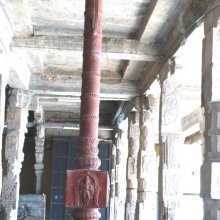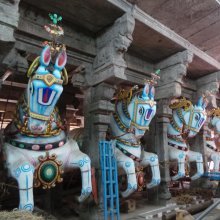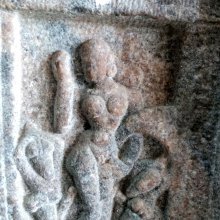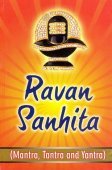Stambha: 33 definitions
Introduction:
Stambha means something in Buddhism, Pali, Hinduism, Sanskrit, Jainism, Prakrit, the history of ancient India, Marathi, Hindi. If you want to know the exact meaning, history, etymology or English translation of this term then check out the descriptions on this page. Add your comment or reference to a book if you want to contribute to this summary article.
Images (photo gallery)
(+6 more images available)
In Hinduism
Shaivism (Shaiva philosophy)
Source: Wisdom Library: Kakṣapuṭa-tantraStambha (स्तम्भ) refers to “immobilizing others”. It is a siddhi (‘supernatural power’) described in chapter one of the Kakṣapuṭatantra (a manual of Tantric practice from the tenth century).
Source: Shodhganga: Mantra-sādhana: Chapter One of the KakṣapuṭatantraStambha (स्तम्भ) refers to “immoilizing others” and represents one of the various siddhis (perfections) mentioned in the Kakṣapuṭatantra verse 1.11-13. Accordingly, “by excellent Sādhakas (tantric practitioners) wishing the Siddhi (e.g., stambha), the mantrasādhana should be performed in advance, for the sake of the Siddhi. One would not attain any Siddhi without the means of mantra-vidhāna (the classification of mantra)”.

Shaiva (शैव, śaiva) or Shaivism (śaivism) represents a tradition of Hinduism worshiping Shiva as the supreme being. Closely related to Shaktism, Shaiva literature includes a range of scriptures, including Tantras, while the root of this tradition may be traced back to the ancient Vedas.
Natyashastra (theatrics and dramaturgy)
Source: Wisdom Library: Nāṭya-śāstraStambha (स्तम्भ, “paralysis”).—One of the eight ‘involutary states’ (sāttvikabhāva), according to the Nāṭyaśāstra chapter 7. These ‘involutary states’ are different from consequents (anubhāva) because of their arising from the inner nature (sattva). The term is used throughout nāṭyaśāstra literature. (Also see the Daśarūpa 4.6-7)
Source: archive.org: Natya ShastraStambha (स्तम्भ, “paralysis”) occurs as being due to joy, fear, sickness, surprise, sadness, intoxication and anger. Paralysis should be represented on the stage by being inactive, motionless, dispirited like an inert object, senseless, and stiff-bodied.

Natyashastra (नाट्यशास्त्र, nāṭyaśāstra) refers to both the ancient Indian tradition (shastra) of performing arts, (natya—theatrics, drama, dance, music), as well as the name of a Sanskrit work dealing with these subjects. It also teaches the rules for composing Dramatic plays (nataka), construction and performance of Theater, and Poetic works (kavya).
Purana and Itihasa (epic history)
Source: archive.org: Puranic EncyclopediaStambha (स्तम्भ).—One of the Saptarṣis (seven hermits) of the Manu-age (Manvantara) of Svārociṣa. The seven ṛṣis of Svārociṣa Manvantara are Ūrja, Stambha, Prāṇa, Vāta, Vṛṣabha, Niraya and Parīvān. (For further details see under Manvantara).
Source: Cologne Digital Sanskrit Dictionaries: The Purana Index1a) Stambha (स्तम्भ).—(kaśyapa)—a son of Parvaśa.*
- * Brahmāṇḍa-purāṇa II. 11. 16.
1b) One of the seven sages of the Svārociṣa epoch.*
- * Viṣṇu-purāṇa III. 1. 11.
1c) Of Śyāma Parāśara clan.*
- * Matsya-purāṇa 201. 37.
1d) The chief types of pillars are five; rucaka (square), vajra (octogonal), dvivajra (sixteen sided), pralīnaka (thirty-two sided) and vṛtta (round); (Vāstu). If the measurements are incorrect there will be fear from kings, thieves and other troubles. The woods for the different sides of a house are vaṭa, udumbara, pippala, plakṣa, etc. Other trees which can be grown around a building are punnāga, aśoka, bakulu, śamī, śilaka, campaka, dāḍimī, pippalī, drākṣa, jambīru, pūga, panasa, ketaki, jāti-saroja, śatapatrika, mallika, nārikela, kadalī, pāṭala, etc. These give auspiciousness to the house.*
- * ^1 Matsya-purāṇa 255. 1-4, 16. ^2 Ib. 255. 20-4.
Stambha (स्तम्भ) is the name of one of the seven sages (saptarṣi) in the Svārociṣa-Manvantara: the second of the fourteen Manvantaras, according to the 10th century Saurapurāṇa: one of the various Upapurāṇas depicting Śaivism.—Accordingly, “In this second [Svārociṣa] Manvantara the deities are the Tuṣitas, Vipaścit is the name of the Indra, and Ūrja, Stambha, Prāṇa, Dānta, Ṛṣabha, Timira and Sārvarivān (Arvarīvān?) are the seven sages”.

The Purana (पुराण, purāṇas) refers to Sanskrit literature preserving ancient India’s vast cultural history, including historical legends, religious ceremonies, various arts and sciences. The eighteen mahapuranas total over 400,000 shlokas (metrical couplets) and date to at least several centuries BCE.
Vastushastra (architecture)
Source: Wisdom Library: Vāstu-śāstraStambha (स्तम्भ) refers to “pillar”.
Source: OpenEdition books: Architectural terms contained in Ajitāgama and RauravāgamaStambha (स्तम्भ) refers to “- 1. pillar, pillar level § 3.16. - 2. upright of a portico (Aj) § 4.31.”.—(For paragraphs cf. Les enseignements architecturaux de l'Ajitāgama et du Rauravāgama by Bruno Dagens)

Vastushastra (वास्तुशास्त्र, vāstuśāstra) refers to the ancient Indian science (shastra) of architecture (vastu), dealing with topics such architecture, sculpture, town-building, fort building and various other constructions. Vastu also deals with the philosophy of the architectural relation with the cosmic universe.
Pancaratra (worship of Nārāyaṇa)
Source: Wisdom Library: PāñcarātraStambha (स्तम्भ) refers to an aspect of nṛsiṃha (‘man-lion’), according to the Vihagendra-saṃhitā 4.17, which mentions seventy-four forms (inlcuding twenty forms of vyūha). He is also known as Stambhanṛsiṃha or Stambhanarasiṃha. Nṛsiṃha is a Tantric deity and refers to the furious (ugra) incarnation of Viṣṇu.
The 15th-century Vihagendra-saṃhīta is a canonical text of the Pāñcarātra corpus and, in twenty-four chapters, deals primarely with meditation on mantras and sacrificial oblations.

Pancaratra (पाञ्चरात्र, pāñcarātra) represents a tradition of Hinduism where Narayana is revered and worshipped. Closeley related to Vaishnavism, the Pancaratra literature includes various Agamas and tantras incorporating many Vaishnava philosophies.
Ayurveda (science of life)
Source: gurumukhi.ru: Ayurveda glossary of termsStambha (स्तम्भ):—Fixedness , stiffness , rigidity , torpor , paralysis , stupefaction

Āyurveda (आयुर्वेद, ayurveda) is a branch of Indian science dealing with medicine, herbalism, taxology, anatomy, surgery, alchemy and related topics. Traditional practice of Āyurveda in ancient India dates back to at least the first millenium BC. Literature is commonly written in Sanskrit using various poetic metres.
Yoga (school of philosophy)
Source: ORA: Amanaska (king of all yogas): A Critical Edition and Annotated Translation by Jason Birch1) Stambha (स्तम्भ) refers to the “mast (of a ship)”, according to the Amanaska Yoga treatise dealing with meditation, absorption, yogic powers and liberation.—Accordingly, as Īśvara says to Vāmadeva: “[...] As long as the highest reality is not known, the mind is unrestrainable. However, when the highest reality is known, the mind becomes [still] like a crow [perched] on the mast of a ship (nau-stambha-kākavat). [...]”.
2) Stambha (स्तम्भ) refers to the “pillar (of mental faculties)”, according to the Amanaska Yoga treatise dealing with meditation, absorption, yogic powers and liberation.—Accordingly, as Īśvara says to Vāmadeva: “[...] For one for whom the no-mind [state] is arising and who is established in [the state of complete] detachment, the body becomes both supple and firm. As soon as the no-mind [state arises,] the bondage of lust, anger and [other such snares] is immediately destroyed. When the [rigid] pillar of mental faculties (antaḥkaraṇa-stambha) has ceased [to exist], the bodily abode becomes loose [and collapses]. [...]”.

Yoga is originally considered a branch of Hindu philosophy (astika), but both ancient and modern Yoga combine the physical, mental and spiritual. Yoga teaches various physical techniques also known as āsanas (postures), used for various purposes (eg., meditation, contemplation, relaxation).
Sports, Arts and Entertainment (wordly enjoyments)
Source: archive.org: Syainika Sastra of Rudradeva with English Translation (art)Stambha (स्तम्भ) refers to “being overcome with amazement”, according to the Śyainika-śāstra: a Sanskrit treatise dealing with the divisions and benefits of Hunting and Hawking, written by Rājā Rudradeva (or Candradeva) in possibly the 13th century.—Accordingly, [while discussing the outlines of hawking]: “[...] At times the hairs stand on end, extreme delight is felt, tears of joy flow, amazement overcomes (stambha), the voice gets choked, anxiety, incoherent talk, change of colour and other symptoms of Sattva guṇa (pure emotion) manifest themselves. [...]”.

This section covers the skills and profiencies of the Kalas (“performing arts”) and Shastras (“sciences”) involving ancient Indian traditions of sports, games, arts, entertainment, love-making and other means of wordly enjoyments. Traditionally these topics were dealt with in Sanskrit treatises explaing the philosophy and the justification of enjoying the pleasures of the senses.
General definition (in Hinduism)
Source: Wisdom Library: HinduismStambha (stiffness) is an Ayurvedic term.
Source: archive.org: Vedic index of Names and SubjectsStambha (स्तम्भ, ‘pillar’) is found in the Kāṭhaka-saṃhitā, and often in the Sūtras. Earlier Skambha is used, but only metaphorically.
In Buddhism
Mahayana (major branch of Buddhism)
Source: Wisdom Library: Maha Prajnaparamita SastraStambha (स्तम्भ) refers to a “column”, according to Mahāprajñāpāramitāśāstra (chapter 3).—Accordingly, “[...] The merchants of the Dharma have gone, from whom can we request the jewel of the Dharma (dharmaratna)? A stanza says: ‘The Buddha has gone to rest forever: he has entered into Nirvāṇa. The multitude of those who have destroyed the bonds has likewise departed. Thus the universe is empty and without knowledge. The shadows of ignorance thicken, the lamp of knowledge is extinguished.’. Then the devas prostrated at the feet of Mahākāśyapa and uttered this stanza: ‘Elder! You have given up desire (rāga), anger (āghāta) and pride (māna). Your body is like a column of red gold (raktasuvarṇa-stambha). From head to toe, you are majestic, marvelous, peerless, The clarity of your eye is pure like the lotus’. [...]”.
Source: De Gruyter: A Buddhist Ritual Manual on AgricultureStambha (स्तम्भ) refers to “stopping (the clouds, cold spells, etc.)” [as taught by the Bhagavān in the ‘great heart called the Garuḍa-flame’], according to the Vajratuṇḍasamayakalparāja, an ancient Buddhist ritual manual on agriculture from the 5th-century (or earlier), containing various instructions for the Sangha to provide agriculture-related services to laypeople including rain-making, weather control and crop protection.

Mahayana (महायान, mahāyāna) is a major branch of Buddhism focusing on the path of a Bodhisattva (spiritual aspirants/ enlightened beings). Extant literature is vast and primarely composed in the Sanskrit language. There are many sūtras of which some of the earliest are the various Prajñāpāramitā sūtras.
In Jainism
General definition (in Jainism)
Source: The University of Sydney: A study of the Twelve Reflections1) Stambha (स्तम्भ) refers to the “post (of the mind)”, according to the 11th century Jñānārṇava, a treatise on Jain Yoga in roughly 2200 Sanskrit verses composed by Śubhacandra.—Accordingly, “Further, for the complete attainment of the desire for liberation, non-attachment, restraint and tranquillity, those [twelve reflections] are tied to the post of the mind (manas-stambha) by mendicants desiring liberation”.
2) Stambha (स्तम्भ) refers to the “trunk (of a tree)”, according to the Jñānārṇava.—Accordingly, “Fool , you must understand, in reality, substance is not acknowledged in a mass of foam, the trunk of a plantain tree (rambhā-stambha) or in the body of human beings. The planets, moon, sun, stars and seasons go and come [but] certainly for embodied souls bodies do not [go and come] even in a dream”.
Source: ORA: Amanaska (king of all yogas): (Jainism)Stambha (स्तम्भ) refers to a “high pillar”, according to the Līlāvatīsāra which was written by the thirteenth-century Jain poet, Jinaratna.—Accordingly, his retelling contains the phrase, [ūrdhvamuṣṭir adhodṛṣṭiḥ (3.257c)], which describes Vatsarāja at the moment before he shoots the arrow. Vatsarāja’s fist is raised up above his head because he must point the bow up to a target above himself, and his gaze is directed down because he must sight the target by gazing at its reflection in a bowl of oil on the ground. A doll (pañcālī) called Rādhā is the target (lakṣya) and she is placed in the middle of a rotating wheel which is suspended atop a high pillar (stambha). One can infer that the “piercing is upward” (ūrdhvavedha) because Vatsarāja's arrow strikes her from below.

Jainism is an Indian religion of Dharma whose doctrine revolves around harmlessness (ahimsa) towards every living being. The two major branches (Digambara and Svetambara) of Jainism stimulate self-control (or, shramana, ‘self-reliance’) and spiritual development through a path of peace for the soul to progess to the ultimate goal.
India history and geography
Source: Cologne Digital Sanskrit Dictionaries: Indian Epigraphical GlossaryStambha.—(BL), a tower. (LL), a pillar. Cf. skambha. (IE 8-6; EI 3), same as Kannaḍa kamma, kamba, kambha; a land measure equal to one-hundredth of a mattaru or nivartana. (SITI), lamp-stand or lamp-post. Note: stambha is defined in the “Indian epigraphical glossary” as it can be found on ancient inscriptions commonly written in Sanskrit, Prakrit or Dravidian languages.

The history of India traces the identification of countries, villages, towns and other regions of India, as well as mythology, zoology, royal dynasties, rulers, tribes, local festivities and traditions and regional languages. Ancient India enjoyed religious freedom and encourages the path of Dharma, a concept common to Buddhism, Hinduism, and Jainism.
Languages of India and abroad
Marathi-English dictionary
Source: DDSA: The Molesworth Marathi and English Dictionarystambha (स्तंभ).—m (S) A post, pillar, or column. 2 Stopped state or the act of stopping, stoppage. 3 Stoppage or suppression (as of urine, the seminal fluid &c., or of any function or faculty): also stupefaction from fear or other affection: also loss of feeling or sensibility, paralysis. 4 Obstruction or hinderance; fixing or fixedness fast and still.
Source: DDSA: The Aryabhusan school dictionary, Marathi-Englishstambha (स्तंभ).—m A spot; stoppage. Obstruction.
Marathi is an Indo-European language having over 70 million native speakers people in (predominantly) Maharashtra India. Marathi, like many other Indo-Aryan languages, evolved from early forms of Prakrit, which itself is a subset of Sanskrit, one of the most ancient languages of the world.
Sanskrit dictionary
Source: DDSA: The practical Sanskrit-English dictionaryStambha (स्तम्भ).—[stambh-ac]
1) Fixedness, stiffness, rigidity, motionlessness; रम्भा स्तम्भं भजति (rambhā stambhaṃ bhajati) Vikr.18.29; Kirātārjunīya 12. 28; गात्रस्तम्भः स्तनमुकुलयोरुत्प्रबन्धः प्रकम्पः (gātrastambhaḥ stanamukulayorutprabandhaḥ prakampaḥ) Mālatīmādhava (Bombay) 2.5; तत्संकल्पो- पहितजडिम स्तम्भमभ्येति गात्रम् (tatsaṃkalpo- pahitajaḍima stambhamabhyeti gātram) 1.35;4.2.
2) Insensibility, stupefaction, stupor, numbness, paralysis.
3) Stoppage, obstruction, hindrance; सोऽपश्यत् प्रणिधानेन संततेः स्तम्भ- कारणम् (so'paśyat praṇidhānena saṃtateḥ stambha- kāraṇam) R.1.74; वाक्स्तम्भं नाटयति (vākstambhaṃ nāṭayati) Mālatīmādhava (Bombay) 8.
4) Restraint, curbing, suppressing; कृतश्चित्तस्तम्भः प्रतिहतधियामञ्जलिरपि (kṛtaścittastambhaḥ pratihatadhiyāmañjalirapi) Bhartṛhari 3.6.
5) Prop, support, fulcrum; नासिराबन्धनार्थाय न शराः स्तम्भहेतवः (nāsirābandhanārthāya na śarāḥ stambhahetavaḥ) Rām.2.23.3.
6) A pillar, column, post.
7) A stem, trunk (of a tree).
8) Stupidity.
9) Absence of feeling or excitability.
1) The suppression of any force or feeling by supernatural or magical means.
11) Stiff-neckedness; जन्मकर्मवयोरूपविद्यैश्वर्य- धनादिभिः । यद्यस्य न भवेत् स्तम्भस्तत्रायं मदनुग्रहः (janmakarmavayorūpavidyaiśvarya- dhanādibhiḥ | yadyasya na bhavet stambhastatrāyaṃ madanugrahaḥ) Bhāgavata 8.22.26.
12) Filling up, stuffing.
Derivable forms: stambhaḥ (स्तम्भः).
Source: Cologne Digital Sanskrit Dictionaries: Shabda-Sagara Sanskrit-English DictionaryStambha (स्तम्भ).—m.
(-mbhaḥ) 1. A post, a pillar, a column. 2. A stalk, a stem. 3. Stupidity, insensibility. 4. Stupefaction from fear, joy, grief, &c. 5. Coldness, (corporeally,) want of feeling or excitability, paralysis. 6. The suppression of any faculty by magical means. 7. Hindrance, obstruction. 8. Fixedness, rigidity. 9. Prop, support, falcrum. 10. Suppressing, curbing. E. ṣṭabhi to stop, &c., aff. ac .
Source: Cologne Digital Sanskrit Dictionaries: Benfey Sanskrit-English DictionaryStambha (स्तम्भ).—[stambh + a], m. 1. A post, a pillar, [Hitopadeśa] 49, 11; [Pañcatantra] i. [distich] 142. 2. A stem, [Hitopadeśa] iv. [distich] 71 (kadalī-, adj. Having the stem of a kadalī, i. e. faintly supported). 3. Obstruction. 4. Stupefaction, [Kirātārjunīya] 12, 28. 5. Stupidity. 6. Insensibility, [Bhartṛhari, (ed. Bohlen.)] 3, 6. 7. Coldness, [Mālatīmādhava, (ed. Calc.)] 80, 7. 8. Paralysis, [Mālatīmādhava, (ed. Calc.)] 21, 7.
Source: Cologne Digital Sanskrit Dictionaries: Cappeller Sanskrit-English DictionaryStambha (स्तम्भ).—[masculine] post, column, prop, support (lit. & [figuratively]); fixedness, stiffness, immobility; obstruction, hindrance, suppression; arrogance, haughtiness.
Source: Cologne Digital Sanskrit Dictionaries: Monier-Williams Sanskrit-English Dictionary1) Stambha (स्तम्भ):—[from stabh] m. (ifc. f(ā). ) a post, pillar, column, stem (as of a tree; also improperly applied to an arm), [Kāṭhaka; Gṛhya-sūtra and śrauta-sūtra; Mahābhārata] etc.
2) [v.s. ...] support, propping, strengthening, [Bhartṛhari]
3) [v.s. ...] inflation, pretentiousness, arrogance, [Mahābhārata; Rāmāyaṇa] etc.
4) [v.s. ...] fixedness, stiffness, rigidity, torpor, paralysis, stupefaction, [Mahābhārata; Kāvya literature] etc.
5) [v.s. ...] becoming hard or solid, [Rājataraṅgiṇī]
6) [v.s. ...] stoppage, obstruction, suppression (also the magical arresting of any feeling or force, as of hunger, thirst, or of the forces of water, fire etc. as taught in the Tantras), [Kāvya literature; Suśruta; Pañcarātra]
7) [v.s. ...] filling up, stuffing, [Rāmāyaṇa]
8) [v.s. ...] Name of a [particular] Adhyāya, [Patañjali on Pāṇini 5-2, 60], [vArttika] 1
9) [v.s. ...] of a Ṛṣi etc., [Viṣṇu-purāṇa] (cf. [gana] kuñjādi and śaunakādi).
Source: Cologne Digital Sanskrit Dictionaries: Yates Sanskrit-English Dictionary1) Stambha (स्तम्भ):—(na, u, ga) stabhnoti 5. a. To stop, hinder; to be stupid or insensible.
2) (mbhaḥ) m. A pillar, post; stem; stupidity; coldness; obstruction.
Source: DDSA: Paia-sadda-mahannavo; a comprehensive Prakrit Hindi dictionary (S)Stambha (स्तम्भ) in the Sanskrit language is related to the Prakrit words: Khaṃbha, Thaṃbha.
[Sanskrit to German]
Sanskrit, also spelled संस्कृतम् (saṃskṛtam), is an ancient language of India commonly seen as the grandmother of the Indo-European language family (even English!). Closely allied with Prakrit and Pali, Sanskrit is more exhaustive in both grammar and terms and has the most extensive collection of literature in the world, greatly surpassing its sister-languages Greek and Latin.
Hindi dictionary
Source: DDSA: A practical Hindi-English dictionaryStaṃbha (स्तंभ) [Also spelled stambh]:—(nm) a column; pillar; stem; stupefaction, torpor; see ~[na;-lekhaka] a columnist, column-writer.
...
Kannada-English dictionary
Source: Alar: Kannada-English corpusStaṃbha (ಸ್ತಂಭ):—
1) [noun] the quaity or state of being rigid, firm, immovable.
2) [noun] the act of stopping, preventing from going ahead, spreading, etc.
3) [noun] a controlling or subjugating.
4) [noun] a pillar; a column.
5) [noun] a stem or trunk (as of a tree).
6) [noun] a regid support; a prop.
7) [noun] a mystical act of preventing, controlling or making inactive.
8) [noun] any of the vertical sections of printed matter that are side by side on a page, separated by a rule or blank space; a column.
9) [noun] (rhet.) the condition or feeling of swooning, fainting.
Kannada is a Dravidian language (as opposed to the Indo-European language family) mainly spoken in the southwestern region of India.
Nepali dictionary
Source: unoes: Nepali-English DictionaryStambha (स्तम्भ):—n. column; a pillar; post;
Nepali is the primary language of the Nepalese people counting almost 20 million native speakers. The country of Nepal is situated in the Himalaya mountain range to the north of India.
See also (Relevant definitions)
Starts with (+23): Stambhabhanjaka, Stambhadipike, Stambhaditya, Stambhak, Stambhaka, Stambhaka-jara, Stambhakara, Stambhakarana, Stambhakari, Stambhaki, Stambhakin, Stambhakridita, Stambhala, Stambhalagana, Stambhalekhaka, Stambhamitra, Stambhan, Stambhana, Stambhanadattatreya, Stambhanadividhi.
Ends with (+111): Adharastambha, Agnistambha, Ahastambha, Ahvana-stambha, Alanastambha, Antahkaranastambha, Anuvishtambha, Apastambha, Astambha, Atidharastambha, Avashtambha, Avishtambha, Bandhanastambha, Bandhastambha, Bhadrakastambha, Bhittistambha, Bhujastambha, Brahmanastambha, Catuhstambha, Chaya-stambha.
Full-text (+262): Stambhakara, Ranastambha, Urustambha, Hanustambha, Khambha, Dvarastambha, Vakstambha, Stambhata, Stambh, Smarastambha, Agnistambha, Stambhakarana, Jayastambha, Stambhayana, Grihastambha, Thambha, Bhujastambha, Kirtistambha, Nihstambha, Mahishistambha.
Relevant text
Search found 56 books and stories containing Stambha, Staṃbha; (plurals include: Stambhas, Staṃbhas). You can also click to the full overview containing English textual excerpts. Below are direct links for the most relevant articles:
Bhakti-rasamrta-sindhu (by Śrīla Rūpa Gosvāmī)
Verse 3.2.67 < [Part 2 - Affection and Service (dāsya-rasa)]
Verse 2.4.90 < [Part 4 - Transient Ecstatic Disturbances (vyābhicāri-bhāva)]
Verse 2.3.18 < [Part 3 - Involuntary Ecstatic Expressions (sattvika-bhāva)]
Brihad Bhagavatamrita (commentary) (by Śrī Śrīmad Bhaktivedānta Nārāyana Gosvāmī Mahārāja)
Verse 2.1.168 < [Chapter 1 - Vairāgya (renunciation)]
Verse 1.5.24 < [Chapter 5 - Priya (the beloved devotees)]
Sahitya-kaumudi by Baladeva Vidyabhushana (by Gaurapada Dāsa)
Text 4.8 < [Chapter 4 - First-rate Poetry]
Text 4.39 < [Chapter 4 - First-rate Poetry]
Text 4.42 < [Chapter 4 - First-rate Poetry]
The Matsya Purana (critical study) (by Kushal Kalita)
Part 2.1 - Measurement of Buildings < [Chapter 7 - Art and Architecture in the Matsyapurāṇa]
Part 3 - Art in the Matsyapurāṇa < [Chapter 7 - Art and Architecture in the Matsyapurāṇa]
Sripura (Archaeological Survey) (by Bikash Chandra Pradhan)
Vaisnava Temples (1): Laksmana Temple < [Chapter 2 - The Architectural Panorama]
Rig Veda (translation and commentary) (by H. H. Wilson)
Rig Veda 1.37.7 < [Sukta 37]
Related products







